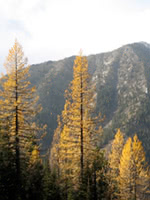Mon-Fri 9am - 5pm Mountain time
Black Locust vs Western Larch
Robinia pseudoacacia
Larix occidentalis
Black Locust is an attractive tree. Its distinctive leaves are made of about a dozen bright green leaflets. It also notable for its fragrant white flowers, which smell of citrus.
Black Locust can grow in many situations, but prefers dry areas with lots of sun. It is robust and is an excellent choice for establishing shade in dry, open areas.
Important note: Much of the Black Locust is toxic to humans and livestock, including seeds, bark, and leaves.
Western Larch is a pioneer species that can survive in nutrient poor soil and is found in the valleys and on the lower slopes of mountains in mixed forests. In the warm months, this larch is covered in clusters of soft green needles that turn golden yellow before dropping in the fall. Its dense, sturdy wood is excellent for lumber, making this Larch valuable in Western North America.

